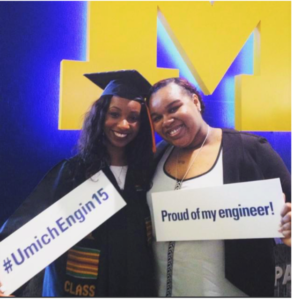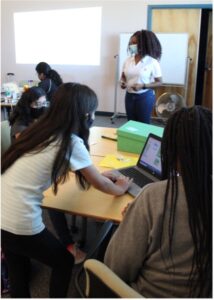Blog Post
Taking Tech Training Into Our Own Hands
Jasmine LeFlore, MSE, MBA • November 10, 2021


Fig 1. REC Innovation Lab Students at San Diego Startup Month Fair
If We Want Diverse Founders, We Have To Let The Kids In On It Too…
San Diego is a booming city when it comes to tech. We are 9th in the nation for tech jobs, 6th on PwC’s regional investment list in 2020 and we have some amazing startups in our backyard like ClickUp, Virbela and Shield AI. We are commonly known for our bio-tech and defense industries while we are becoming a more established innovation economy by the day. As San Diego’s tech ecosystem continues to grow, (especially with the support of San Diego Startup Month and The REC Innovation Lab), we have a unique opportunity to establish secondary educational pathways for underserved communities to partake in the growth of our tech utopia.
Sonia Steinway’s article was spot on. The current landscape of diverse founders is not yet ideal. She highlighted how Black and Latinx founders only raise about 2.4% of all venture funding. I can imagine that this statistic is probably even less for founders of color in San Diego. I believe that the numbers are so stark for startups with diverse founders typically because most communities of color don’t even know startup or entrepreneurship is a viable career pathway for them early on in their lives.
I normally ask the many angel investors, VCs and founders I come across – ‘how’d you get into startup or entrepreneurship?’ The most common answer is some rendition of “My dad was an executive”. “My granddad was a business owner”. My usual thought is – well what if you’re not from a family of business owners or executive decision makers? How would you know that is an option?
I was born and raised from Flint, MI where if anyone in your family worked on the shopfloor at GM, people thought you had ‘money’. The advice for me was simply just to “go to college and get a good job”. I personally had no opportunities of nepotism, no invite or birthright into the “good ol’ boys club”, and no warm intros built into my DNA. I relied on the resources of the community. The main one in particular was called the Carrera Program, an after school program that exposed at-risk urban youth to career and professional development opportunities as an effort to prevent teenage pregnancy.

Fig 3. Jasmine LeFlore Mcdonald’s employee ‘selfie’

Fig 4. Graduating from UM Aero
The career spark for me was when the Carrera Program took us on a college tour to the University of Michigan aerospace department when I was in the 9th grade. I always had a fascination of airplanes as a kid, but this tour was my ‘a-ha moment’. I knew then and there I would be studying aerospace engineering at the University of Michigan. Overall, I was always a pretty smart kid but after that tour I transformed into this high achieving all American high schooler – I was the National Honor Society Vice President, Captain of the Cheer Team, Track and Field School record breaker, Student Council Representative, a member of the Robotics Team (shout out to Team 397 Knight Riders), all while maintaining a part-time job at McDonalds just to save up for my car, my senior pictures and my grad party. By 11th grade, I was in full swing, I took an engineering graphics class at the Skill Center and landed an internship at Wade Trim Civil Engineering firm. I even did a pre-college engineering program at Kettering University called AIM (Academically Interested Minds) where I stayed on Kettering’s campus for 4 weeks and took engineering classes like a real college student.
Wayyy easier said than done, I eventually accomplished my goal of graduating from The University of Michigan with an Aerospace engineering degree and now work at one of the largest Aerospace and Defense companies of the world. It worked! I made it through the proverbial ‘leaky tech pipeline’. I was exposed to STEM at an early age. But what if I was exposed to business around that age at the same time? Would I have already built the next big tech unicorn? Quite frankly, I just learned about entrepreneurship about 3 years ago and Venture Capital about a year and a half ago. I actually just learned difference between a VC and an angel investor maybe 8 months ago, and where I come from, I am ahead of the curve about any conversations around investing.

Fig 2. Jasmine LeFlore with Carerra Program Leaders
This was one of the sole reasons I co-founded Greater Than Tech (GTT), a nonprofit organization dedicated to creating the next technology business leaders of the future, by teaching girls of color the intersectionality of engineering and business. I soon learned on my social entrepreneurship journey that by having a program that was
paying tech jobs to get in the door (at large corporations), but they also need exposure to build their own door (entrepreneurship).
As you can see, the TLDR version is the need for exposure – more exposure to wealth creating opportunities through tech such as startup and intellectual property. There is no doubt that tech is and will continue to be the future. It’s past time for middle school and high school students of underserved communities to feel confident in not only learning and excelling in tech but also knowing they can create and own their tech too. Designed for girls of color in mind, any student could benefit from this knowledge as well.
I want underserved students to know that they can define their own path in tech whether they want to grow up to be a leader at a big tech company or develop their own big tech company. GTT instills the importance of self-efficacy, teamwork, and an entrepreneurial mindset in all our STEM programming. Students learn the engineering design process and a high-level version of the business model canvas. At the end of each program, there is always a Demo of the tech the students created, as well as a business pitch. You can think of it as a ‘Robotics Competition meets Shark Tank’. I’ve held various versions of this framework with students ages 11 – 17, and there’s nothing like seeing what aspect of the program each kid clings onto. Some love the tech and coming up with innovative ways to still meet the design requirements. Some kids get hooked onto the coding. Some love the creating the company branding or figuring out the customer relationships, and some just like to dictate how the team spends the “company money.” Either way, these are all very key roles to a startup atmosphere or even corporate leadership. By going through a Greater Than Tech program, it expands their horizons in knowing they can be limitless in STEM.
Communities of color not only need advocacy for high paying tech jobs to get in the door (at large corporations), but they also need exposure to build their own door (entrepreneurship).
As you can see, the TLDR version is the need for exposure – more exposure to wealth creating opportunities through tech such as startup and intellectual property. There is no doubt that tech is and will continue to be the future. It’s past time for middle school and high school students of underserved communities to feel confident in not only learning and exceling in tech but also knowing they can create and own their tech too.

Fig 5. Team of students reviewing code



